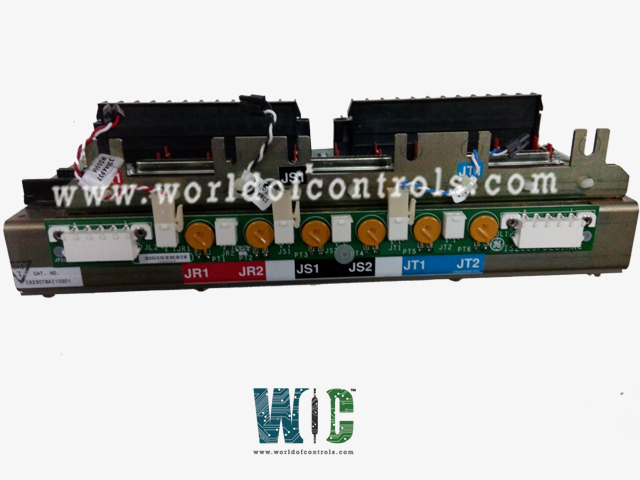
World Of Controls understands the criticality of your requirement and works towards reducing the lead time as much as possible.
IS230TBAI1CG - Analog Input/Output (TBAI) Terminal Board is available in stock which ships the same day.
IS230TBAI1CG - Analog Input/Output (TBAI) Terminal Board comes in UNUSED as well as REBUILT condition.
To avail our best deals for IS230TBAI1CG - Analog Input/Output (TBAI) Terminal Board, contact us and we will get back to you within 24 hours.
SPECIFICATIONS:
Part Number: IS230TBAI1CG
Manufacturer: General Electric
Series: Mark VIe
Function: Analog Input/Output (TBAI) Terminal Board
Number of channels: 12 channels (10 AI, 2 AO)
Input span, transmitters: 1-5 V dc from 4-20 mA
Dimensions: 0.16 cm wide x 33.02 cm
Operating Temperature: -30 to 65°C
Controller and I/O module Redundancy: Simplex
Internal operating system: QNX
Operating Voltage: 9 V to 16 V dc
Power Consumption: 4 W
Maximumleadresistance: 15Ωmax
Output Load: 500 Ω for 4-20 mA
Analog outputs: 0 to 10 V
Outputs: 24 V
Configuration Software: ToolboxST
Ethernet Ports: 2 Ethernet ports
Country of Manufacture: United States (USA)
Availability: In Stock
Manual: GEH-6421M
FUNCTIONAL DESCRIPTION:
IS230TBAI1CG is an Analog Input/Output Terminal Board manufactured and designed by General Electric as part of the Mark VIe Series used in GE Distributed Control Systems. The Analog Input/Output (TBAI) terminal board can handle ten analog inputs and two outputs. The ten analog inputs support two-wire, three-wire, four-wire, and externally powered transmitters. The analog outputs can be configured for 0-20 mA or 0-200 mA current. Noise suppression circuitry protects the inputs and outputs from surges and high-frequency noise. TBAI includes three DC-37 pin connectors for connecting to I/O processors. Simplex applications are supported by a single connector (JR1). TMR applications are compatible with all three connectors. In TMR applications, input signals are routed to three connectors for the R, S, and T controls. TMR outputs combine the currents of the three connected output drivers to calculate the overall current using a measuring shunt.
INSTALLATION:
Connect the input and output wires to two I/O terminal blocks located on the terminal board. Each block has two screws and 24 terminals that accommodate wires up to #12 AWG. Each terminal block has an attachment point for the shield terminal. TBAI supports the following analog I/O types:
OPERATION:
TBAI supplies a 24 V dc power source for all transducers. Jumpers (J#A and J#B) allow you to specify the inputs as current or voltage. One of the two analog output circuits has a 4-20 mA range, while the other can be set to 0-200 mA. The following table shows the analog I/O capabilities of the TBAI. Each 24 V dc power output is rated to supply 21 mA continuously and is safeguarded against short circuits. Transmitters/transducers can be powered by the control system's 24 V dc source or by an external power supply. Jumper JO determines the type of current output. Diagnostics monitor each output, and a suicide relay in the I/O controller disconnects the relevant output.
WOC has the largest stock of GE Distributed Control System Replacement Parts. We can also supply unused and rebuilt backed-up with a warranty. Our team of experts is available round the clock to support your OEM needs. Our team of experts at WOC is happy to assist you with any of your automation requirements. For pricing and availability on any parts and repairs, kindly get in touch with our team by phone or email.
How does an Analog Input Terminal Board work?
An Analog Input Terminal Board typically samples analog signals from sensors or other sources and converts them into digital values that can be processed by a computer or microcontroller. This conversion process involves analog-to-digital converters (ADCs) on the board.
How does an Analog Output Terminal Board work?
An Analog Output Terminal Board generates analog output signals based on digital input values received from a computer or controller. This is achieved using digital-to-analog converters (DACs) on the board.
What types of analog signals can be processed by these boards?
Analog Input/Output Terminal Boards can handle various types of analog signals including voltage levels (0-10V, -10V to +10V), current signals (4-20 mA), and resistance measurements from sensors like thermistors or strain gauges.